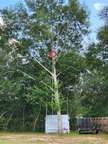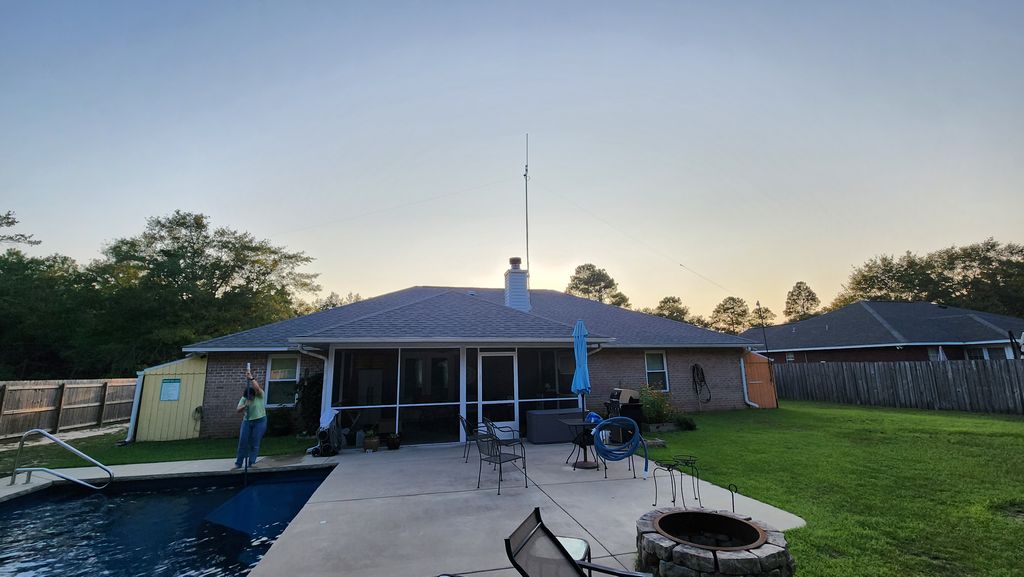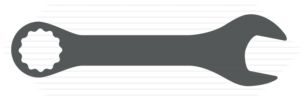
Image: The yoke holding the pulley is there.
Let one thing be perfectly clear: I am an old man.
I am past both the social and legal definition of retirement age. I still work full-time, and will continue to do so as long as they want me and I want to do it.
This probably comes as no surprise, but old men don't have the strength and stamina they had in their younger days. I am painfully aware of this. It's why when I started thinking about putting a pulley in this tree behind the house, I first started thinking about how much it would cost to rent a cherry-picker or have the guys at Kevin's Tree Service stop by and use theirs.
. . . but first: the back story.
I bought the ARRL Antenna book. I also bought the end-fed wire antenna kit they offer.
My current 10 to 40 meter antenna is an Off-Center Fed dipole in a slight inverted V configuration. The (off) center is right at 30' off the ground, but the whole antenna is right above the roof of the house. It's probably 10-15' above the shingles.
The theory is, if I put this End-Fed wire antenna between my antenna pole and this tree, that antenna might have better performance because it will have nothing under it except our swimming pool for its entire length. An added potential benefit is it would be oriented at 90 degrees to the other wire antenna, which in my mind means it should give me options I don't have now.
I wanted the far end of the antenna to be as high as I could get it. I visually selected a branch as my target. Then I started designing my plan of action.
At first, I contemplated a cherry-picker as I mentioned earlier. That led to thinking about the complexity of that whole approach. That led to an exclaimation: Just climb the damn tree! I felt like I could do it. I was mostly sure I would survive. I have survived before. Several times, actually.
As it turns out, I did survive. I lived to tell the tale.
The Plan:

The feed end of this antenna will go right up there beside the feed point for the OCF wire. I will add a line to the front eave of the house to absorb the tension this new antenna might put on the pole.
The far end will be attached to some parachute cord and sent through a pulley at the tree in question. That pulley will be lofted by means of a rope in a second pulley that I am going to permanently suspend from a strong limb in this tree.
This permanent pulley is attached by means of a yoke designed to be strong and long-lasting, and also to avoid choking or otherwise damaging the tree. This pulley allows me to use a heavier rope than what I would use on an antenna line. So if the smaller line on the antenna is damaged and comes out of its pulley, I can get that pulley down without having to climb again.
As long as the rope to the primary pulley is useable, there will be no more tree climbing related to this antenna.
The Process:
I chose a stainless steel shackle, a swivel pulley, and 1/4" braided Nylon rope. These components should withstand the elements about as long as I will.
I put my yoke together with a piece of steel cable inside a length of 1/2" watertight flex conduit. Looped the two ends and secured the loops with a couple of wire rope clamps. Added a stainless shackle and a swivel pulley and we were ready.
I dug my old climbing belt and some straps and carabiners out of the ancient backpack I haven't opened since 2012. At least it still fit, so there's that.
My spouse insisted on being there to witness my demise should I violate the First Rule of Climbing,
which is: Don't Fall Down
It's also the First Rule for Motorcyle Riding, by the way.
Next I drug out the monstrously heavy Werner ladder which I have regretted buying from day one. (The Gorilla brand cost more, but is 4lbs lighter. [36.9 vs 41])
Get all the pieces and parts attached to my belt. Tie one end of the Nylon rope to the belt. Ascend the ladder . . . and start up the tree.
The secret to surviving any such endeavor is simply never, never, never get in a hurry. Know where you are going before you move. Make sure what you're about to put weight on can hold it. Strive to keep three points landed at all time.
I went up slowly, carefully, moving my safety strap higher with each stage of the ascent. I was about six feet below my intended target when I realized it would be foolish to attempt it. So I settled for a spot about 3' below that which I could safely reach.
I strapped the yoke around the branch, attached the pulley with the rope through it, used a piece of 12AWG solid copper to lock the pin in the shackle, then after de-looping a branch, sent both ends of the rope down to my lovely assistant.
I decended the same way I came up, but more slowly. And then it was done. I felt great!
The Rest of the Story
After I put up the first antenna, I googled how to calculate the height of something like an antenna. There is a graphic in the gallery below that lays out what I learned.
Today's goal is achieved. The primary pulley is in the tree. Now I need to assemble the balun kit and pull another coax out to my antenna pole. Then I'll be ready to give this thing a whirl.
The Pics:
Thanks to the spousal unit (KC5JBT) for the pics. Nice job!
Apparently my body is, for the most part, still a Thing That Works!. What a pleasant surprise! 73 de KB5SBW.






